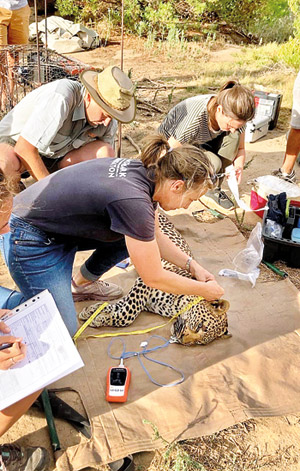Man and leopard co-existing, lessons from South Africa

At work: Dr. Jeannine McManus collaring a leopard
While it is easy to love the leopard, the elusive predator with the mystique of a lone ranger, the life of an ecologist working with the big cat in South Africa is not entirely one of glamour and adventure.
Dr. Jeannine McManus from South Africa, here to deliver the Wildlife and Nature Protection Society (WNPS) lecture for July, has worked hard to lessen the clash between the majestic feline and farmers – a unique skirmish in that ‘Chui’ (Swahili for leopard) is the only big predator found outside of the national parks – the lion, the cheetah and hyena being restricted to the reserves.
The lecture to be held on July 25 is titled Leopards, People and Everything and is organised to coincide with Sri Lanka Leopard Day on August 1, as concern for our own ‘kotiya’ mounts.
For Jeannine, it all began in her parents’ farm in Eastern Cape, South Africa. A stream ran through the green land and in the shrub roamed small antelope – common duiker, cape grysbok and porcupines, bush pigs, and yellow mongoose. It was a tempting ‘entree’ into the world of the wild savanna.
The leopard is not only the most charismatic of big cats, it can adapt to any terrain apart from the true desert and escape any fence. While South Africa’s heavy-maned cape lion and cheetah became extinct in the 1850s and 1970s respectively, the Panthera pardus pardus, could find refuge within the inhospitable mountain regions, and survived.
For the same reason, as it is found in production landscapes, it has been persecuted by humans. However, the presence of leopards means that ecosystem is healthy, so a ‘major conservation focus’ today is promoting the co-existence of humans and leopards in production landscapes.
In order to learn more about these big cats, monitoring is essential, and working with the Landmark Foundation, a conservation organisation in South Africa, Jeannine and her team have collared 73 leopards apart from rescuing some 120.
“Complex, scary and exciting” is how Jeannine describes the collaring process. Explaining that it is a key part of reducing conflict, she says: “When farmers have livestock losses due to leopards they contact us. We then offer a financial compensation incentive to let us capture, collar and release the animal on the spot it was caught. This offers a ‘safety net’ for the farmer who suffered the losses.”
The animal is sedated by a vet, morphological information and DNA samples are taken, and a drop-off satellite collar is attached. The collar drops off without there being a need to remove it and spatial information can be obtained of individual leopards.
The collars offer a lifeline for the leopard whose presence near livestock can now be detected and the farmers alerted, thus saving the leopard and reducing conflict. The collar beeps across a wealth of data.
“These data opened up a world of information. We have been able to estimate their densities, predict habitat, connectivity, genetic structure, understand what promotes and precludes leopards from landscapes.”
It’s been a steep learning curve, but many a mystery is yet to be cleared up, she says, “like, what is the genetic distribution of leopards in South Africa? How does this spill over into the pan-African distribution and beyond? Where are the genetic ‘pinch points’ and how can we promote connectivity across the landscape ?”
The work is not all in the bush. “Working with people is key.” The team includes Dr. Bool Smuts, founder and manager of Landmark Foundation; Dr. Lauriane Faraut, an ethologist who worked on primates in Senegal and South Africa and runs field operations; and Monica Vacarro, a passionate educator and artist who dreams up creative ways to reach out to communities.
It’s a tough situation out there, she remarks in response to a question if she has had any favourites among the leopards they encounter. “It’s hard to get attached to them, several we rescued (having been) killed months or a couple of years later due to the high level of conflict, and in some cases our efforts only afforded these individuals additional time before being killed.
“One cat, Becky, was an exciting tough young adult female leopard living on the banks of the Orange River, bordering South Africa and Namibia. But only a few months after collaring her, she was shot and killed by a farmer’s son worried about potential conflict on a livestock farm. It’s tough.”
As for the human-leopard conflict in the upcountry tea estates in Sri Lanka, Jeannine notes that finding effective solutions requires a comprehensive approach that meets the needs of both people and the species.
“Key strategies include raising awareness among communities about coexistence practices and safety measures to prevent encounters, protecting livestock during vulnerable periods and employing deterrents like auditory and visual measures.
“Crucially, understanding leopard biology and the driving factors of conflict as inadequate habitat availability and habitat quality, and prey availability, is critical in mitigating conflict. Ultimately, fostering community engagement and promoting a willingness to coexist are pivotal in implementing effective, sustainable solutions to minimize human-leopard conflict.
“If there is willingness, there are ways to effectively mitigate conflict,” she says.
The Nations Trust WNPS lecture ‘Leopards, people and everything…’ will be held on Thursday, July 25 at 6 p.m. at Jasmine Hall, BMICH and is open to all
Searching for an ideal partner? Find your soul mate on Hitad.lk, Sri Lanka's favourite marriage proposals page. With Hitad.lk matrimonial advertisements you have access to thousands of ads from potential suitors who are looking for someone just like you.


